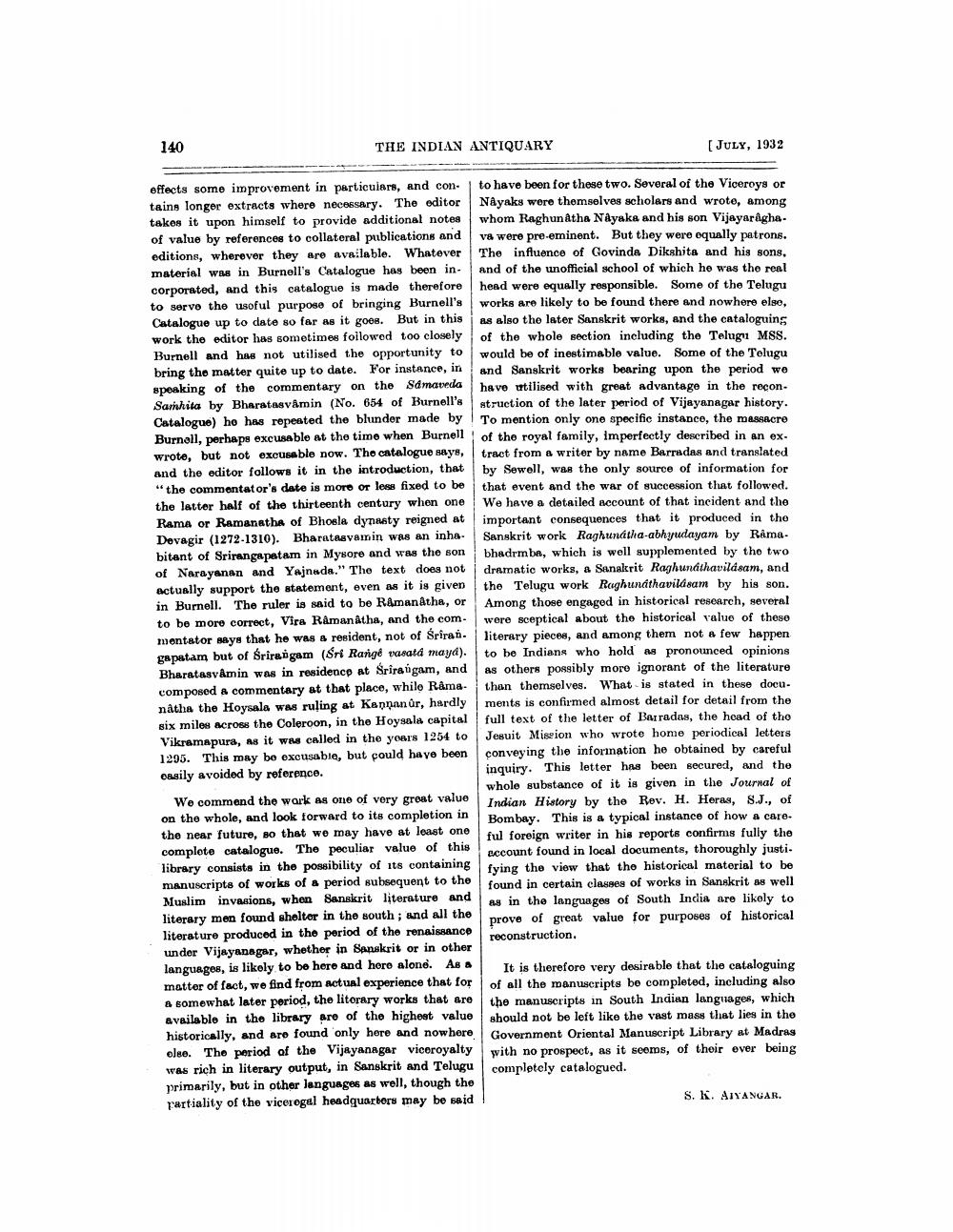________________
140
THE INDIAN ANTIQUARY
(JULY, 1932
effects some improvement in particulars, and con. to have been for these two. Several of the Viceroys or tains longer extracts where necessary. The editor Nåyaks were themselves scholars and wrote, among takes it upon himself to provide additional notes whom Raghunatha Nayaka and his son Vijayaragha. of value by references to collateral publications and va were pre-eminent. But they were equally patrons. editions, wherever they are available. Whatever The influence of Govinda Dikshita and his sons. material was in Burnell's Catalogue has been in and of the unofficial school of which he was the real corporated, and this catalogue is made therefore head were equally responsible. Some of the Telugu to serve the usoful purpose of bringing Burnell's works are likely to be found there and nowhere else, Catalogue up to date so far as it goes. But in this as also the later Sanskrit works, and the cataloguins work the editor has sometimes followed too closely of the whole section including the Telugri MSS. Burnell and has not utilised the opportunity to would be of inestimable value. Some of the Telugu bring the matter quite up to date. For instance, in and Sanskrit works bearing upon the period we speaking of the commentary on the sdmaueda have utilised with great advantage in the reconSanhita by Bharatasvâmin (No. 654 of Burnell's struction of the later period of Vijayanagar history. Catalogue) ho has repeated the blunder made by to mention only one specific instance, the massacre Burnell, perhaps excusable at the time when Burnell of the royal family, imperfectly described in an exwrote, but not excusable now. The catalogue says, tract from a writer by name Barradas and translated and the editor follows it in the introduction, that by Sewell, was the only source of information for "the commentator's date is more or less fixed to be that event and the war of succession that followed. the latter half of the thirteenth century whon one We have a detailed account of that incident and the Rama or Ramanatha of Bhosla dynasty reigned at important consequences that it produced in the Devagir (1272-1310). Bharatasvamin was an inha- Sanskrit work Raghunatha-abhyudayam by Rama. bitant of Srirangapatam in Mysore and was the son bhadrmba, which is well supplemented by the two of Narayanan and Yajnada." The text does not dramatic works, a Sanakrit Raghunathavildsam, and actually support the statement, oven as it is given the Telugu work Raghunathavilásam by his son. in Burnell. The ruler is said to be Ramanatha, or Among those engaged in historical research, several to be more correct, Vira Ramanatha, and the com- were sceptical about the historical value of these mentator says that he wAS & resident, not of Sriran. literary pieces, and among them not a few happen capatam but of Srirangam (Sri Rango wanatd maya). I to be Indians who hold a pronounced opinions BharatasvAmin was in residence at Sriraugam, and as others possibly more ignorant of the literature composed a commentary at that place, whilo Rama. than themselves. What is stated in these docunátha the Hoysala was ruling at Kannanur, hardly ments is confirmed almost detail for detail from the six miles across the Coleroon, in the Hoysala capital full text of the letter of Barradas, the head of tho Vikramapura, as it was onlled in the years 1254 to Jesuit Mision who wrote home periodical letters 1995. This may be excusable, but could have been conveying the information he obtained by careful casily avoided by reference.
inquiry. This letter has been secured, and the
whole substance of it is given in the Journal of We commend the work as one of very great value Indian History by the Rev. H. Heras, S.J., of on the whole, and look forward to its completion in
Bombay. This is a typical instance of how a carethe near future, so that we may have at least one
ful foreign writer in his reports confirms fully the complete catalogue. The peculiar value of this
Eccount found in local documents, thoroughly justi. library consists in the possibility of its containing
fying the view that the historical material to be manuscripts of works of a period subsequent to the
found in certain classes of works in Sanskrit as well Muslim invasions, when Sanskrit literature and
as in the languages of South India are likely to literary men found shelter in the south; and all the
prove of great value for purposes of historical literature produced in the period of the renaissance
reconstruction. under Vijayanagar, whether in Sanskrit or in other languages, is likely to be here and here alone. As
It is therefore very desirable that the cataloguing matter of fact, we find from actual experience that for
of all the manuscripts be completed, including also & somewhat later period, the litorary works that are the manuscripts in South Indian languages, which available in the library are of the highest value should not be left like the vast mass that lies in the historically, and are found only here and nowhere Government Oriental Manuscript Library at Madras olee. The period of the Vijayanagar vicoroyalty with no prospect, as it seems, of their over being was rich in literary output, in Sanskrit and Telugu completely catalogued. primarily, but in other languages as well, though the rartiality of the vicerogel headquarters may be said
S. K. AIYANGAR.




